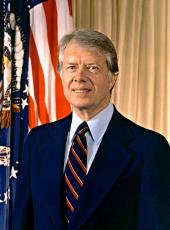By the President of the United States of America
A Proclamation
The Noatak River basin is the largest mountain-ringed river basin in the Nation still virtually unaffected by technological human activity. This basin has been designated as a Biosphere Reserve under the United Nations' auspices, in recognition of its international importance for scientific study and research.
The area includes landforms and ecological variations of scientific interest. The Grand Canyon of the Noatak River is a dissected valley 65 miles long. The area contains the northwesternmost fringe of boreal forest in North America, and is a transition zone and migration route for plants and animals between subarctic and arctic environments. The diversity of the flora is among the greatest anywhere in the earth's northern latitudes.
The Noatak Valley area contains a rich variety of birdlife including several Asian species. The area is crossed twice a year by two-thirds of the Western Arctic caribou herd, and is prime habitat for the barren ground grizzly bear, moose, and several predator species.
Nearly 200 archeological sites, dating as far back in time as 5,000 years, are within the area. They give promise of future discoveries leading to a deeper understanding of the area's prehistory.
The Noatak basin is an area where indigenous plants and animals perpetuate themselves naturally, in a freely functioning ecosystem. Protection of this area will assure the preservation of an essential base against which scientists may judge environmental dynamics of the future.
The land withdrawn and reserved by this Proclamation for the protection of the geological, archeological, biological, and other phenomena enumerated above supports now, as it has in the past, the unique subsistence culture of the local residents. The continued existence of this culture, which depends upon subsistence hunting, and its availability for study, enhances the historic and scientific values of the natural objects protected herein because of the ongoing interaction of the subsistence culture with those objects. Accordingly, the opportunity for local residents to engage in subsistence hunting is a value to be protected and will continue trader the administration of the monument.
Section 2 of the Act of June 8, 1906 (34 Stat. 225, 16 U.S.C. 431), authorizes the President, in his discretion, to declare by public proclamation historic landmarks, historic and prehistoric structures, and other objects of historic or scientific interest that are situated upon the lands owned or controlled by the Government of the United States to be national monuments, and to reserve as part thereof parcels of land, the limits of which in all cases shall be confined to the smallest area compatible with the proper care and management of the objects to be protected.
Now, Therefore, I, Jimmy Carter, President of the United States of America, by the authority vested in me by Section 2 of the Act of June 8, 1906 (34 Stat. 225, 16 U.S.C. 431), do proclaim that there are hereby set apart and reserved as the Noatak National Monument all lands, including submerged lands, and waters owned or controlled by the United States within the boundaries of the area depicted as the Noatak National Monument on the map numbered NOAT-90,004 attached to and forming a part of this Proclamation. The area reserved consists of approximately 5,800,000 acres, and is the smallest area compatible with the proper care and management of the objects to be protected. Lands, including submerged lands, and waters within these boundaries not owned by the United States shall be reserved as a part of the monument upon acquisition of title thereto by the United States.
All lands, including submerged lands, and all waters within the boundaries of this monument are hereby appropriated and withdrawn from entry, location, selection, sale or other disposition under the public land laws, other than exchange. There is also reserved all water necessary to the proper care and management of those objects protected by this monument and for the proper administration of the monument in accordance with applicable laws.
The establishment of this monument is subject to valid existing rights, including, but not limited to, valid selections under the Alaska Native Claims Settlement Act, as amended (43 U.S.C. 1601 et seq.), and under or confirmed in the Alaska Statehood Act (48 U.S.C. Note preceding Section 21 ).
Nothing in this Proclamation shall be deemed to revoke any existing withdrawal, reservation or appropriation, including any withdrawal under Section 17 (d) (1) of the Alaska Native Claims Settlement Act (43 U.S.C. 1616(d)(1)); however, the national monument shall be the dominant reservation. Nothing in this Proclamation is intended to modify or revoke the terms of the Memorandum of Understanding dated September 1, 1972, entered into between the State of Alaska and the United States as part of the negotiated settlement of Alaska v. Morton, Civil No. A-48-72 (D. Alaska, Complaint filed April 10, 1972).
The Secretary of the Interior shall promulgate such regulations as are appropriate, including regulation of the opportunity to engage in a subsistence lifestyle by local residents. The Secretary may close the national monument, or any portion thereof, to subsistence uses of a particular fish, wildlife or plant population if necessary for reasons of public safety, administration, or to ensure the natural stability or continued viability of such population.
Warning is hereby given to all unauthorized persons not to appropriate, injure, destroy or remove any feature of this monument and not to locate or settle upon any of the lauds thereof.
In Witness Whereof, I have hereunto set my hand this 1st day of December, in the year of our Lord nineteen hundred and seventy-eight, and of the Independence of the United States of America the two hundred and third.

JIMMY CARTER
Note: The maps detailing the boundaries of the Noatak National Monument are printed in the FEDERAL REGISTER of December 5, 1978.
Jimmy Carter, Proclamation 4624—Noatak National Monument Online by Gerhard Peters and John T. Woolley, The American Presidency Project https://www.presidency.ucsb.edu/node/244441

